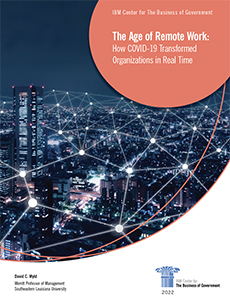
Challenges and Opportunities for the Future of the Remote Workplace: Perspectives from an Expert in Response to a Recent Center Report

Our Center recently released a new report, The Age of Remote Work: How COVID-19 Transformed Organizations in Real Time, that addressed challenges and opportunities for remote work, given the continued acceleration of workplace change emerging during the pandemic. We welcome continued dialogue based on the provocative questions that Steve raises for future research on this topic.
The Age of Remote Work – Success and Challenges
Insights from Steve Goodrich
I read with interest the IBM Center report on The Age of Remote Work authored by David Wyld. For those that manage and work remotely, it is a comprehensive look at the strengths, structures, and approaches to organizational telework and outlines new way of managing remote workers.
Of particular interest to me is to see how the dramatic increase in telework matures over time, what successes will continue, and what challenges will be faced. While telework is not a consideration for a large part of the American workforce (i.e., medical professionals, retail workers, factory workers), it is a reality for the government and professional service workforce. For my organization, telework has been a large part of the culture well before COVID and thus was an easy transition.
It would be interesting to know how organizations are anticipating and addressing some of the challenges, however. For example, will employee onboarding and assimilation into new workplaces such as fully remote or hybrid arrangement take more time? Will fully remote or hybrid workplaces lead to diminishing performance and productivity? Will staff become weary over time in a 24/7 home environment and want an alternative place to go for a change of scenery, to get away from visiting relatives, or when internet speeds decrease?
Also, what are the mental health implications for workforces that go fully remote or operate in a hybrid environment? Is the growing rate of the mental health profession growing due to other factors or directly attributable to telework? Further, how are organizations adapting their quality control? How are people meeting their social contact needs? Do we still need to come together physically for often messy interactive innovation, ideation, or strategy sessions? Will organizations experience higher than normal attrition if they require too much in-office participation?
A lot of things to think about and I am interested in seeing the long term impact and adjustments organizations will make over time. Thank you, the IBM Center for The Business of Government and David Wyld for great and stimulating research.



